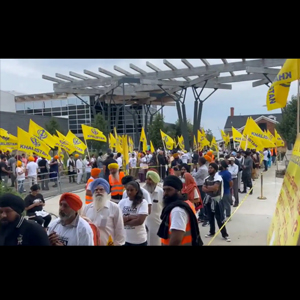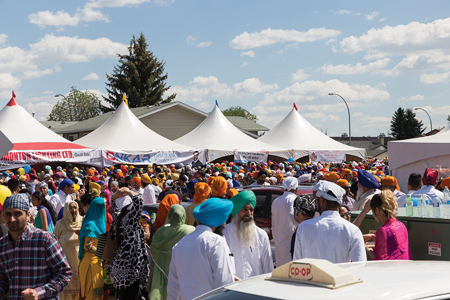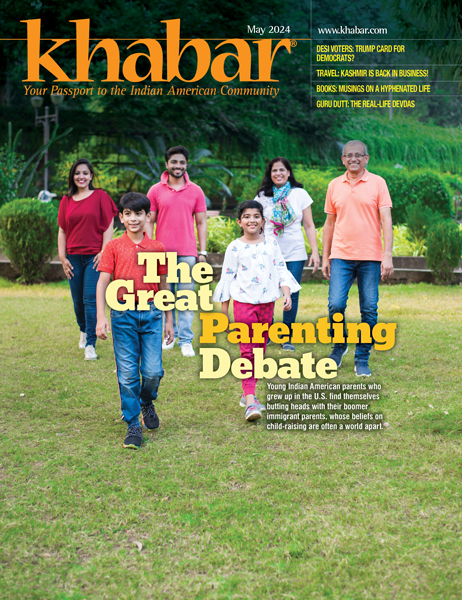Perspective: Why Are Khalistanis Thriving in Canada?

[Left] Supporters line up to vote for a Khalistan Referendum in Brampton, Ontario. (Photo: @Azhar Javaid on X)
The perception of popular support among Canadian Sikhs for the secession of Punjab from India to create a separate nation called Khalistan is misleading. It’s only because of the Khalistani control of Canadian gurdwaras—and the political clout that comes from it— has the movement gained momentum. A majority of Canadian Sikhs do not see eye-to-eye with Khalistanis.
Until Prime Minister Justin Trudeau made the bombshell statement in September about “credible allegations of a potential link between agents of the Government of India (GOI) and the killing of a Canadian citizen, Hardeep Singh Nijjar,” many in the Indo-Canadian community believed that Nijjar was gunned down at a Surrey gurdwara because of rivalries between competing groups of Sikh hardliners in Canada.
However, Khalistani groups issued statements claiming it was the Indian government that was responsible for the assassination of Nijjar. The fact that PM Trudeau not only endorsed that allegation, but also went so far as to antagonize India by his somewhat reckless accusation against GOI, has been a big boost for the Khalistanis’ campaign against India.
Talk to any Sikh in the Greater Toronto area or in Vancouver, and they will tell you that it’s only a small number that is creating problems in Canada in the name of Khalistan. A radio show host who regularly talks to people on this issue in Brampton, a suburb of Toronto that is heavily populated with Sikhs, says, “I would put the number of Canadian Sikhs supporting the idea of Khalistan to not more than three-four
percent. That’s it.”
A nexus of gurudwaras and politics
Then why has the Khalistani movement flourished in Canada? Mainly because this small percentage of radicals is a very united and vocal group. And they control most of the gurdwaras—where their power flows from. The gurudwaras have a big hold on the diasporic Sikh community because everybody comes to pay obeisance at these religious places. “Once you control gurdwaras and the community, you attract politicians of all hues. No political leader will miss visiting gurdwaras because they get big receptive audiences at these places,” says Balraj Deol, a Punjabi journalist from Brampton.
Unlike the gurdwaras in India, which are run by autonomous bodies such as the Shiromani Gurdwara Parbandhak Committee (SGPC) or the Delhi Sikh Gurdwara Management Committee (DSGMC), Sikh temples in Canada are controlled by individual groups that are mostly pro-Khalistan. These groups give membership of their gurdwara committees only to their own relatives, friends, and village kith and kin so that they never lose control of management. Since gurdwaras collect millions of dollars through offerings, they also enjoy financial power which they use to favor their own people (by giving them supply contracts, for example) and further their political agenda by funding politicians and political parties.
Deol believes that, over the years, Khalistanis have gained political clout in a proportion far beyond their small numbers (as a percentage of the population). By patronizing and funding politicians, the younger generation of Khalistanis have risen to the ranks of Members of Parliament. According to Deol, Khalistanis have become very adept at manipulating the political system in Canada through their control of the gurudwaras. “This explains the political clout of Khalistanis and why the movement has flourished in Canada,” he says.
Arguing on the same lines, a Sikh businessman from Brampton, who requests anonymity, says, “That’s how these Khalistanis got Jagmeet Singh elected as MP and leader of the New Democratic Party (NDP).” The NDP has a huge sway over Trudeau’s fortunes in the political system of Canada. “It is as simple as that. It is pure manipulation of the Canadian political system by the Khalistanis,” says the businessman.
Silencing the moderates
It is often asked why moderate Sikhs are not vocal in opposing the Khalistanis that are, after all, a small fraction of the Sikh community in Canada. “Well, the Khalistanis have become adept at silencing anyone opposing them. They have put social media savvy people in their political offices. Whenever any incon-venient issue arises, they unleash their criticism through their social media network to oppose or suppress it. Similarly, if any moderate Sikh raises their voice against them, they start getting threatening messages, forcing them to keep quiet. The Khalistanis have used social media to silence their critics,” says the Sikh businessman from Brampton.
 The Khalistani movement in Canada
The Khalistani movement in Canada
The history of the Khalistani movement in Canada goes back to the 1970s when the late Khalistani leader Jagjit Singh Chohan, Uday Singh Sudbury who was a math professor at Laurentian University in Sudbury, and others raised the demand for Khalistan from Canadian soil.
[Right] According to many community watchers, a majority of Canadian Sikhs do not support the Khalistan movement. (Photo: Mack Male, Wikicommons)
The movement deepened in the early 1980s when many Sikhs came to Canada as refugees or asylum seekers after the start of Dharam Yudh Morcha by the Akalis in Punjab and the storming of the Golden Temple by the Indian Army to flush out Jarnail Singh Bhindranwale and his supporters in June 1984.
These refugees/asylum seekers were mostly Jat Sikhs. “They knew how to use their dominant position in Punjab villages to further their agenda in Canada,” says Brampton journalist Deol. “The first thing they did was to take control of the gurudwaras in Canada from the moderates. The Air India Kanishka bombing and killings of some prominent moderates followed soon after. Talwinder Singh Parmar, who was the mastermind of the 1985 Air India Kanishka bombing, and many prominent radical Khalistanis came to Canada at that time.”
As the numbers of the Sikh community grew, huge parades on occasions such as Vaisakhi in Vancouver and Toronto started attracting record crowds. In turn, these record crowds started attracting Canadian politicians. Organizers of these parades started using these occasions to raise the banner of Khalistan. And this continues to this day. The Khalistanis are also using many newly-arrived students from Punjab for their cause, rallies, parades, and even the Khalistan referendum vote.
The Nijjar assassination and its repercussions
The killing of Nijjar has only added a new chapter to the Khalistan movement in Canada as the radicals are using the allegations by Trudeau to fuel resentment in the community against India. Nobody knows what the outcome of Canadian investigations into the alleged Indian hand in the Nijjar killing will be. But one major outcome of this episode is the consolidation of the ranks of the Hindu community in this country. Not many of them think that what Trudeau has done is right. It means that the Hindu community—which accounts for more than half of the Indian diaspora of about 1.8 million in Canada—may now politically align with the Conservative Party as opposed to Trudeau’s Liberal Party. This realignment could change the results in many constituencies (ridings) in Toronto and Vancouver areas.
Even many moderate Sikhs could abandon Trudeau’s Liberal Party as a huge segment of the Sikh community is very unhappy about the current state of affairs between India and Canada.
Amidst all this, what is heartening is that there is hardly any polarization among the Hindus and the Sikhs except for the Khalistani elements. But in the long run, the danger is that many Canadian-born Khalistanis have been so deeply brainwashed by their parents that it’s difficult to predict the end of the Khalistan movement in Canada anytime soon.
Yet, one thing is sure: the Khalistan movement will never enjoy backing from the Sikh majority in Canada.
Based in Toronto, Gurmukh Singh is the Canada correspondent for the Indo-Asian News Service (IANS).
Enjoyed reading Khabar magazine? Subscribe to Khabar and get a full digital copy of this Indian-American community magazine.
blog comments powered by Disqus












